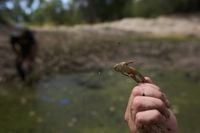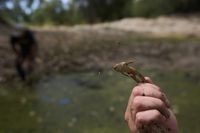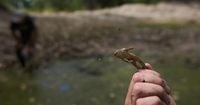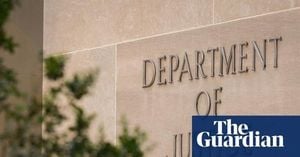On a quiet morning at the Santa Rosa Plateau Ecological Reserve in Southern California, a herpetologist named Brad Hollingsworth squats at the edge of a pond, boots caked in mud. He isn’t here to catch frogs or disturb the delicate ecosystem. Instead, he retrieves a small recording device, eager to discover what secrets its memory card holds. Back at his office in the San Diego Natural History Museum, Hollingsworth loads the data and, within minutes, artificial intelligence sifts through 18 hours of sound. Amid the cacophony of owl hoots, woodpecker pecks, and coyote howls, he hears something remarkable: the breeding call of the red-legged frog, a native species that had all but vanished from the region.
This moment, confirmed on January 30, 2025, marked a major turning point for a species that once thrived across California’s coastal wetlands and into Baja California, Mexico. According to the Associated Press, red-legged frogs, which grow between 2 to 5 inches long, were once so abundant that their crimson hind legs became a delicacy during the Gold Rush era. They even inspired Mark Twain’s famous 1865 story, “The Celebrated Jumping Frog of Calaveras County.” But over the last century, the frogs’ numbers plummeted. The introduction of invasive bullfrogs—bigger, hungrier, and carrying deadly diseases—along with relentless habitat loss from drought and development, decimated the native population. Hollingsworth estimates that red-legged frogs have disappeared from 95% of their historic range in Southern California.
The story of their return is one of perseverance, scientific ingenuity, and cross-border cooperation. For decades, biologists like Robert Fisher of the U.S. Geological Survey scoured nearly 250 miles from Los Angeles to the Mexican border, searching for survivors. In 2001, Fisher found a single frog. After that, nothing. But scientists refused to give up. DNA analysis of preserved frogs hinted that the original Southern California population was genetically closer to frogs in Baja California than to any remaining in California. In 2006, a team including Hollingsworth, Fisher, and then-student Anny Peralta traveled to Baja. They found about 20 red-legged frogs and a glimmer of hope.
Inspired by this discovery, Peralta and her husband founded Fauna del Noroeste, a nonprofit in Ensenada, Mexico, dedicated to restoring natural habitats. By 2018, they had constructed ponds in Mexico to nurture the fragile frog population. The plan was ambitious: grow the numbers in Baja, then transport egg masses across the border to repopulate Southern California. But just as the project was gaining momentum, the COVID-19 pandemic threw up new barriers. With the border closed and international travel restricted, the team scrambled to secure permits and a pilot willing to fly the precious cargo—two coolers filled with frog eggs—closer to the border. After a careful inspection by U.S. authorities, the eggs made their way north by road.
The next five years were filled with uncertainty. Would the eggs hatch? Would the frogs survive and breed in their new home? The answers finally arrived in early 2025. Using AI-powered audio analysis, Hollingsworth and his team detected the distinct grunting calls of male red-legged frogs in the reserve’s ponds. “It felt like a big burden off my shoulder because we were thinking the project might be failing,” Hollingsworth told the Associated Press. “And then the next couple nights we started hearing more and more and more, and more, and more.” By March, the first egg mass was discovered beneath a monitoring microphone, clear evidence that the relocated frogs had matured and bred successfully in the wild.
This success was not just a scientific milestone—it was a triumph of binational collaboration. As of August 11, 2025, herpetologist Bennet Hardy was photographed holding a lively red-legged froglet in a restoration pond outside El Coyote, Mexico, part of the ongoing cross-border effort. According to AP photo editors, conservationists on both sides of the border are now working together to ensure the species’ survival. The Baja population has soared from about 20 to as many as 400 adult frogs, providing a steady source of eggs for future relocations. Meanwhile, more than 100 adult red-legged frogs now inhabit Southern California ponds, with tadpoles spotted at a new site—signs of a growing, self-sustaining population.
Technology has played a crucial role in this comeback. Conservationists are increasingly turning to artificial intelligence to monitor endangered animals, track breeding, and gather data on environmental threats. As Zachary Principe of The Nature Conservancy explained, AI tools—originally developed for analyzing bird sounds—are now being adapted to identify amphibian calls and track their behavior. This shift has saved scientists countless hours of painstaking listening, allowing them to pick out the subtle thumb-on-balloon sound of the red-legged frog amid a noisy backdrop of tree frogs, cows, and passing motorcycles. “There’s tree frogs calling, there’s cows mooing, a road nearby with a motorcycle zooming back and forth,” Hollingsworth described. “There’s owls, there’s ducks splashing, just all this noise.”
Looking ahead, the team hopes to integrate satellite technology that will send real-time audio recordings directly to their phones. This would enable them to act quickly if predators—especially invasive bullfrogs—are detected, and help track the elusive frogs, whose cold-blooded nature makes them invisible to thermal cameras. The combination of AI and satellite monitoring promises to revolutionize amphibian conservation, not just for red-legged frogs but for other species teetering on the brink.
The red-legged frog’s resurgence is part of a broader pattern of binational conservation along the nearly 2,000-mile U.S.-Mexico border. Other species, like the Mexican gray wolf and the California condor, have also made comebacks thanks to coordinated efforts on both sides. The frog’s return has even had unexpected benefits: fewer mosquitoes, which can carry diseases like dengue and Zika, have been observed at restoration sites.
For Anny Peralta, the frogs’ journey transcends borders and bureaucracy. “They don’t know about borders or visas or passports,” she told the Associated Press. “This is just their habitat and these populations need to reconnect. I think this shows that we can restore this ecosystem.”
As the sun sets over the Santa Rosa Plateau, the chorus of red-legged frogs is more than just a sound—it’s a testament to resilience, cooperation, and the enduring possibility of renewal, even against daunting odds.






